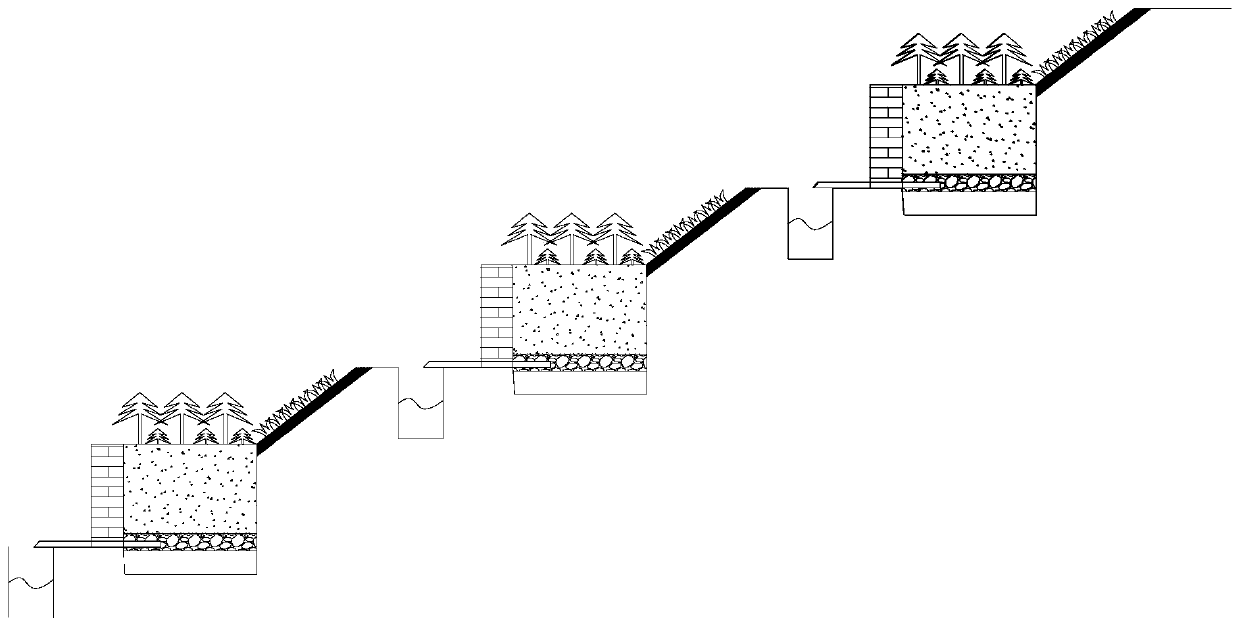Ecological restoration method for slope vegetation
A technology of ecological restoration and vegetation, applied in botany equipment and methods, soil preparation methods, excavation, etc., can solve the problems of incomplete ecological restoration, poor ecology, and short validity period of slope vegetation, so as to reduce the risk of landslides and Probability, good ecology, and high restoration rate
- Summary
- Abstract
- Description
- Claims
- Application Information
AI Technical Summary
Problems solved by technology
Method used
Image
Examples
Embodiment 1
[0036] The slope vegetation ecological restoration method includes the following steps:
[0037] Step 1. Carry out stepped slope cutting to form several platforms and slopes. On the platform, set a brick wall with the same width as the slope and facing the slope. The depth of the brick wall embedded in the ground is 500-800mm. The height is 800-1000mm, the thickness is 300-500mm, and the brick wall is plastered with C25 cement;
[0038] Step 2, filling the planting substrate between the brick wall and the slope facing it to form a planting groove, and planting shrubs and / or trees in the planting groove;
[0039] Step 3, mixing foreign soil, low-alkalinity cement, water-retaining agent, herb seeds and / or shrub seeds and water to make a concrete mixture, and spraying the concrete mixture on the slope; this implementation In an example, the weight ratio of each component is guest soil: low-alkalinity cement: water-retaining agent: herb seeds and / or shrub seeds: water=50:3:2:1:40...
Embodiment 2
[0044] The difference between this example and Example 1 is that due to the serious soil erosion of the slope, there are basically no microorganisms in the soil in some abandoned slopes, the land is very barren, and the plants planted by spraying will appear after a period of production. Withering phenomenon, by testing the soil of several such slopes, it is found that the soil fertility in these areas is very low, and the content of microorganisms and organic matter is relatively small. The following steps are followed:
[0045] Step A, opening several first grouting holes with a depth of 1.5m to 4m on the slope;
[0046] Step B. Mix organic matter, microorganisms, fertilizers, water-retaining agents, adhesives, soil and water into a sticky paste, and pour it into the first grouting hole through a grouting pump; in this embodiment, the weight ratio of each component is Organic matter: fertilizer: water retaining agent: binder:, soil: water = 1:12:8:6:54:41;
[0047] Step C,...
Embodiment 3
[0050] The difference between this embodiment and implementation 2 is that there are more heavy metal ions in some soils. The existence of heavy metal ions will not only affect the normal growth of plants, but also if heavy metal ions enter the domestic water, it will also affect the area. The health of residents is affected, so the degradation of heavy metal ions is also very important in the slope treatment process, so the present embodiment also includes the following steps:
[0051] Step D: Open several second grouting holes on the platform and part of the slope between the brick wall and the slope facing it, the depth of the second grouting holes is 2m-6m; Insert a thin tube made of biodegradable plastic into the grouting hole; several permeable holes are provided on the side wall of the thin tube; the degradable plastic is PBS in this embodiment;
[0052] Step E, select municipal sludge from a nearby city, add water with heterotrophic bacteria, stir and mix to form a sti...
PUM
 Login to View More
Login to View More Abstract
Description
Claims
Application Information
 Login to View More
Login to View More - R&D
- Intellectual Property
- Life Sciences
- Materials
- Tech Scout
- Unparalleled Data Quality
- Higher Quality Content
- 60% Fewer Hallucinations
Browse by: Latest US Patents, China's latest patents, Technical Efficacy Thesaurus, Application Domain, Technology Topic, Popular Technical Reports.
© 2025 PatSnap. All rights reserved.Legal|Privacy policy|Modern Slavery Act Transparency Statement|Sitemap|About US| Contact US: help@patsnap.com


